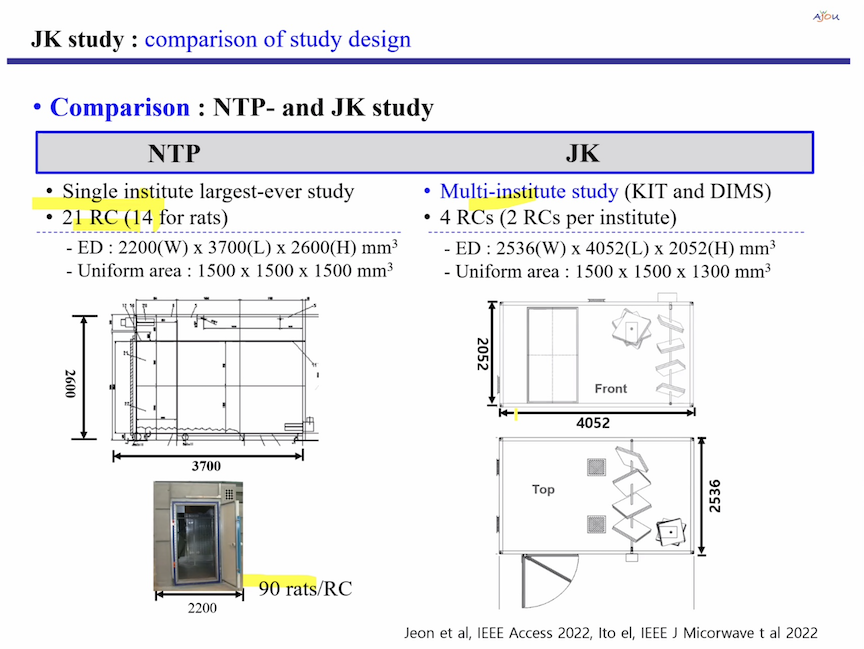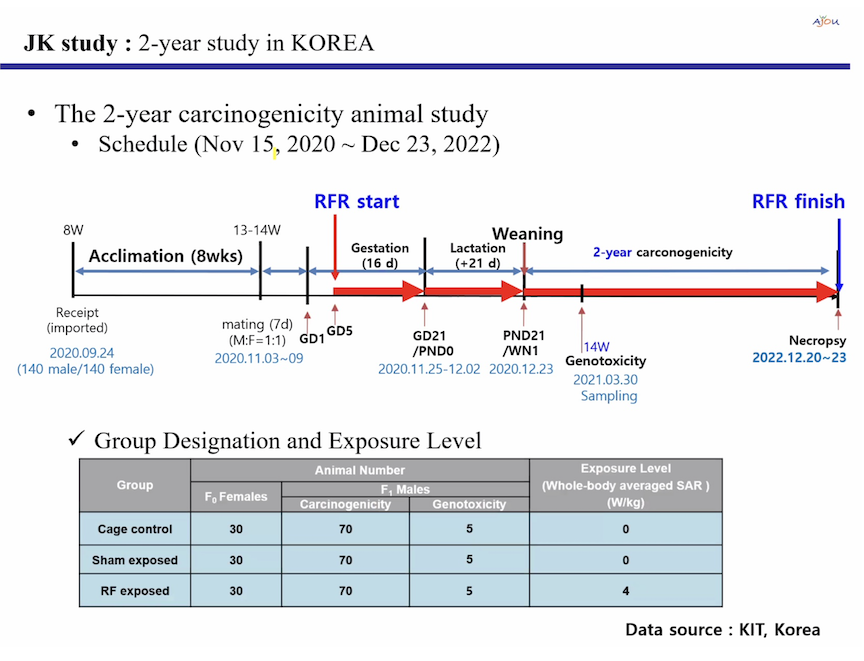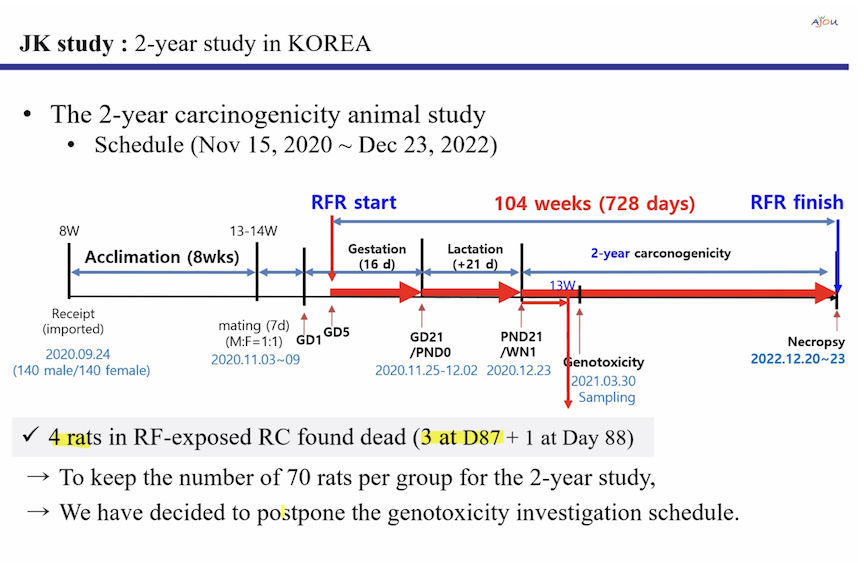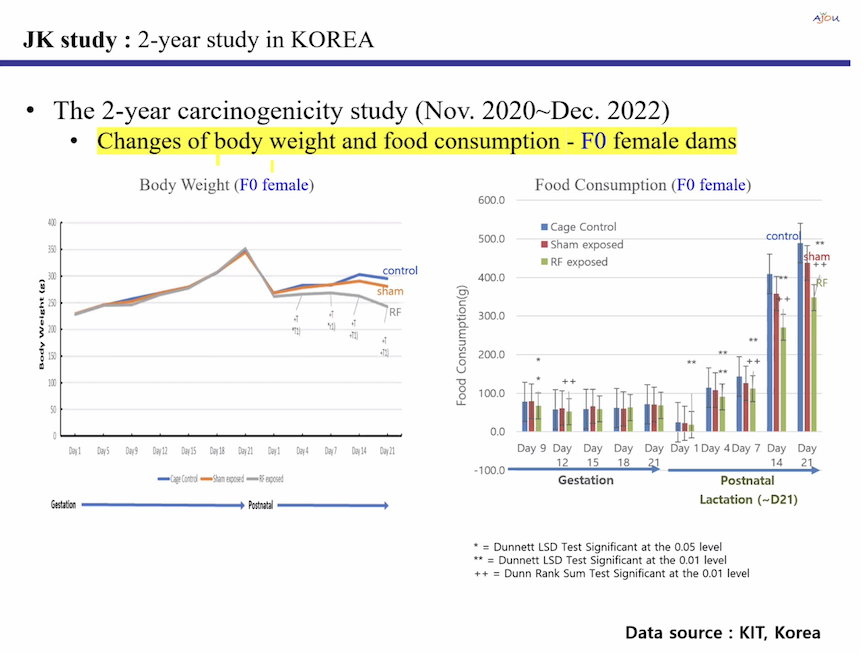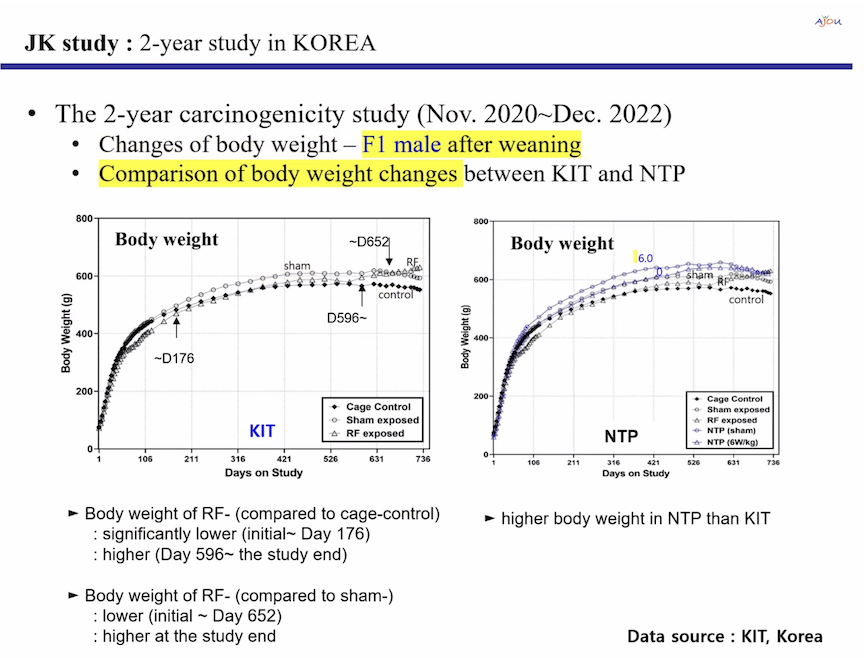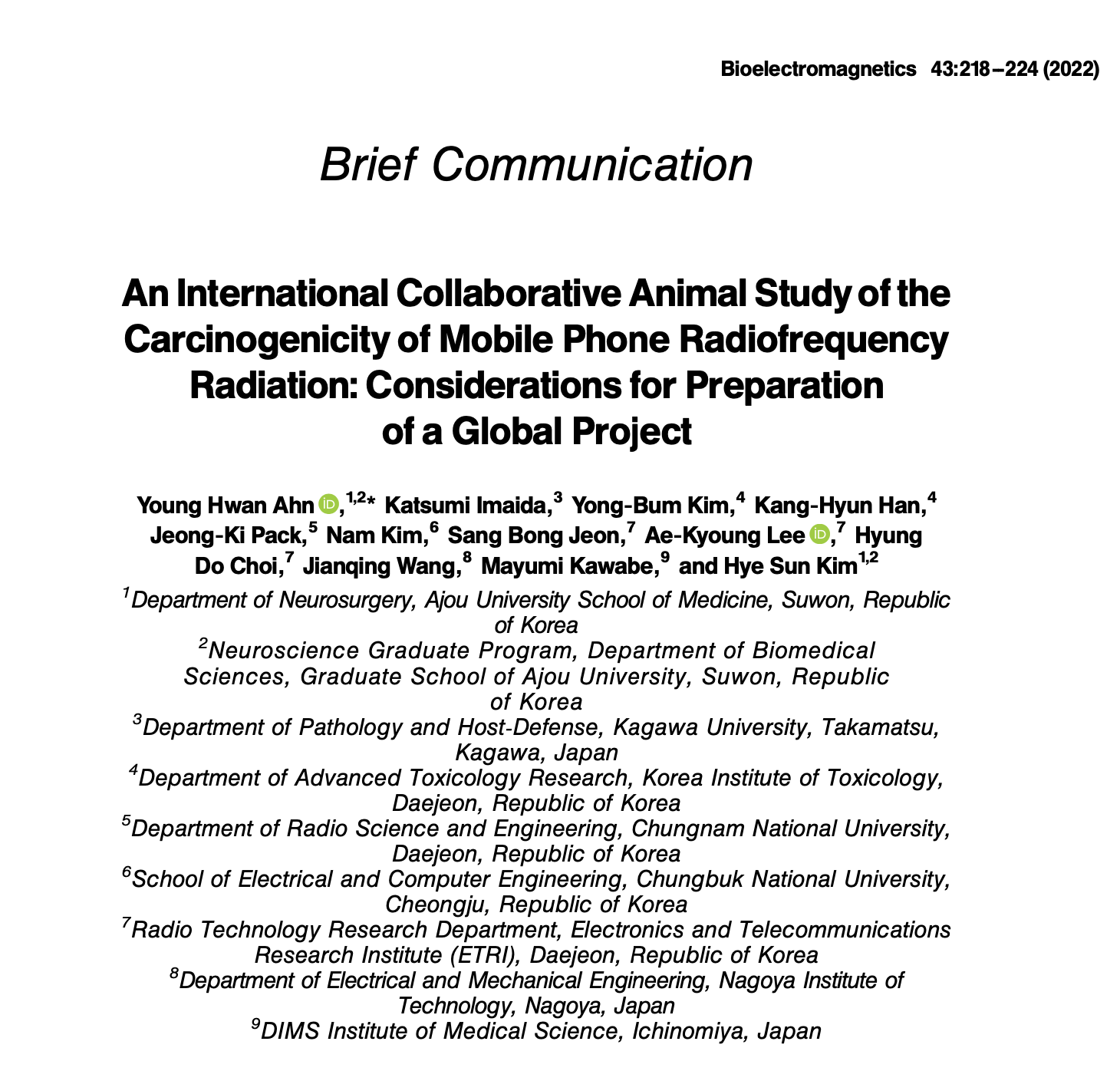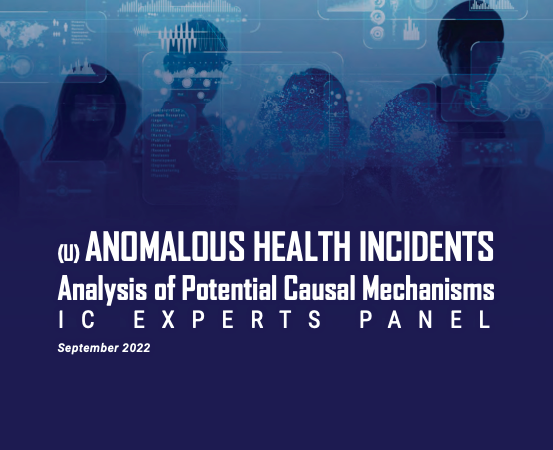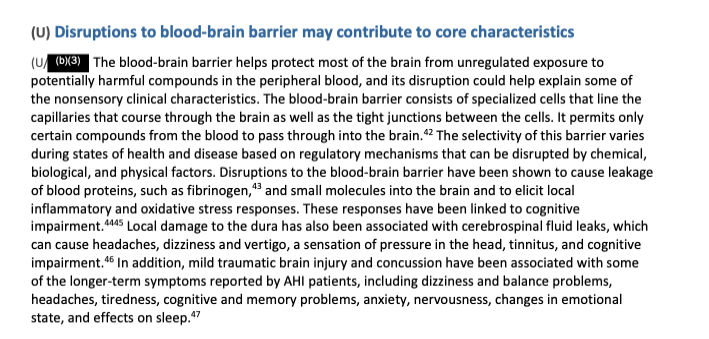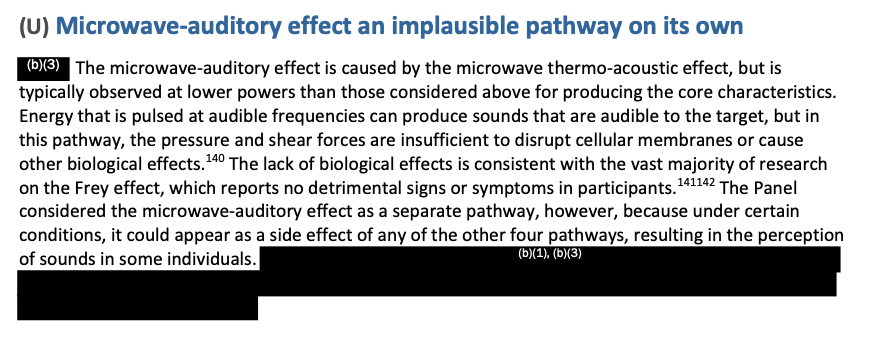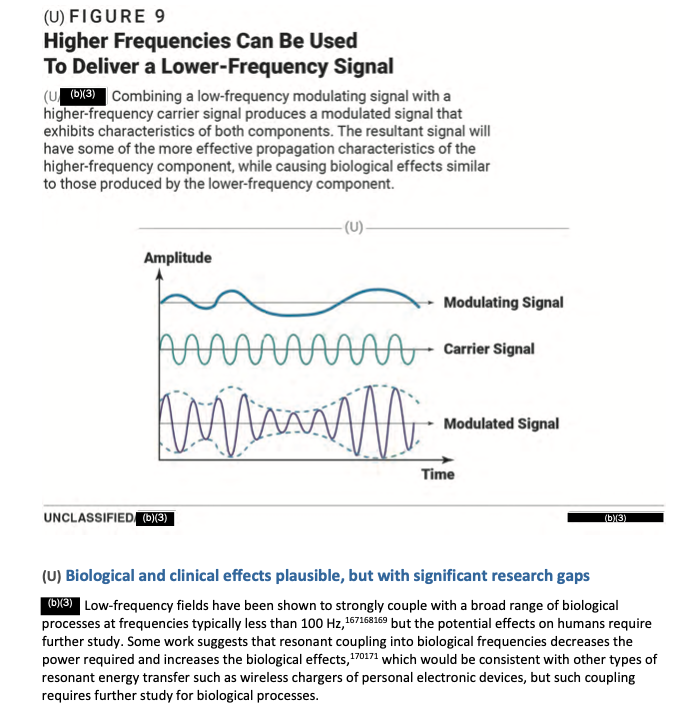2023 Short Takes
Did Cell Phone in Trouser Pocket Lead to a Tumor in the Thigh?
Three medical doctors have published a case report of a 40-year-old Italian man who developed a tumor in his thigh, near where he “habitually” kept his smartphone in a trouser pocket.
The case was published at the end of August in Radiology Case Reports, a peer-reviewed, open access journal.
The tumor, a painless mass, gradually expanded in the man’s left thigh over a period of six months, they wrote. It grew in his Schwann cells and is known as a schwannoma. It was benign.
Schwann cells play an important role in the functioning of the peripheral nervous system. They make up the myelin sheath, which insulates nerve fibers and helps speed the conduction of electrical impulses. They are present in most organs of the body —whether of mice, rats or humans.
The authors —two Italians and one Moroccan— acknowledge that they “cannot establish a definitive causal relationship” between the tumor and the placement of the phone in the trouser pocket, but they state that the case underscores the “need for further research.”
Second Report in Preparation
Microwave News has learned of a second, similar case, as yet unpublished, also in Italy. It deals with a schwannoma that developed in a woman’s forearm, close to a pocket where she put a cell phone while doing sports for about one hour a day, every day for more than ten years.
This latter case is being written up by Fiorella Belpoggi, the former scientific director of the Ramazzini Institute outside Bologna. She retired in 2019 but continues to be one of the institute’s scientific advisors. Belpoggi ran Ramazzini’s long-term RF exposure study, which found schwannoma of the heart among exposed rats (more here).
The U.S. National Toxicology Program (NTP) saw malignant schwannoma of the heart among its RF–exposed rats. This is what led to the now well-known conclusion that there is “clear evidence” of cancer following RF exposure.
The NTP found schwannomas in a variety of glands (pituitary, salivary and thymus), as well as the trigeminal (cranial) nerve and the eye. The NTP saw schwannomas in the uterus, ovary and vagina of female rats.
The fact that both Ramazzini and the NTP bioassays showed the same type of obscure tumor led some observers to opine that “more than a coincidence” was at work (more here).
Acoustic Neuroma Is a Type of Schwannoma
An acoustic neuroma is a tumor on the nerve connecting the ear to the brain. It too is a schwannoma. It has long been associated with cell phone use. A link was first reported by Sweden’s Lennart Hardell in 2002, and supported by Maria Feychting of the Karolinska Institute and other members of the Interphone project. (More about this history here). Feychting later changed her mind and became an outspoken critic of any cell phone tumor risk.
In 2012, the Supreme Court of Italy affirmed a workers’ compensation award to a businessman who developed a tumor of the trigeminal nerve after using a cell phone for 12 years. (A similar award, also in Italy, here.)
So Are Gliomas
What is not widely recognized is that the brain’s glial cells are related to Schwann cells, as explained by the NTP in its final report of its RF project:
“Schwann cells are similar to glial cells in the brain in that they are specialized supportive cells whose functions include maintaining homeostasis, forming myelin and providing support and protection for neurons of the peripheral nervous system.”
Glial cells are in the central nervous system; Schwann cells are in the peripheral nervous system. They serve similar functions.
Gliomas, tumors of glial cells, are the other type of tumor most often associated with cell phone use.
Schwannoma in Muscle Tissue
A schwannoma “can occur anywhere in your body, at any age,” according to the Mayo Clinic: In an arm or leg, it manifests as a slow-growing, painless lump. It is rarely cancerous, but can lead to nerve damage and loss of muscle control.
The Cleveland Clinic states that schwannomas are usually found among people between the ages of 50 and 60 years —and rarely in children. They are uncommon, affecting fewer than 200,000 people each year in the U.S.; about 60% of benign schwannomas are vestibular schwannomas (acoustic neuromas).
In most cases, according to the Cleveland Clinic, schwannomas “happen randomly for unknown reasons.”
A team from Korea presented a case report of a schwannoma in the muscles of a 79-year-old man’s back in the journal Nerve in 2020. The tumor, when removed, measured 2.0 × 2.0 × 3.5 cm. The report is open access.
__________________
For other reasons to keep a phone out of your pocket, see:
Colorectal Cancer Soaring in Young Adults; Are Smartphones in the Mix?
Briefing at WHO RF Meeting in Geneva
A Korean RF genotoxicology study —part of a joint project with Japan— has been delayed due to the unexpected death of four RF–exposed rats early in the accompanying two-year cancer experiment, according to Young Hwan Ahn of Korea’s Ajou University medical school.
Ahn presented a progress report on the Korean arm of the project in Geneva last week at a by-invitation-only meeting of the WHO EMF Project’s International Advisory Committee.
Microwave News has obtained a copy of Ahn’s PowerPoint presentation.
There were 70 RF-exposed rats in the two-year cancer study and an additional five for the genotox experiment. Three rats died in the RF–exposure chamber on the 87th day of the experiment, and another died the next day. The team decided to combine the two sets of rats to maintain the statistical power of the cancer bioassay. The cause of the four deaths, if known, was not disclosed.
Exposures in the cancer studies in both countries ended last December. The animals have been sacrificed and the analyses are now under way. Exposures in the delayed genotox experiment are scheduled to be completed in September.
The cancer results are expected in 2024. The director of IARC, Elisabete Weiderpass, has said that she is waiting for them before assembling a new panel to evaluate RF–cancer risks.
The Japanese/Korean animal study is a scaled-down repeat of the $30 million study by the U.S. National Toxicology Program (NTP) which found clear evidence that RF radiation can cause cancer. The Asian study has been called “NTP Lite.”
Katsumi Imaida will present a progress report on the Japanese arm of the joint project at the annual BioEM meeting in Oxford next week (his abstract).
The three slides below compare the Japanese/Korean studies to the original NTP project:
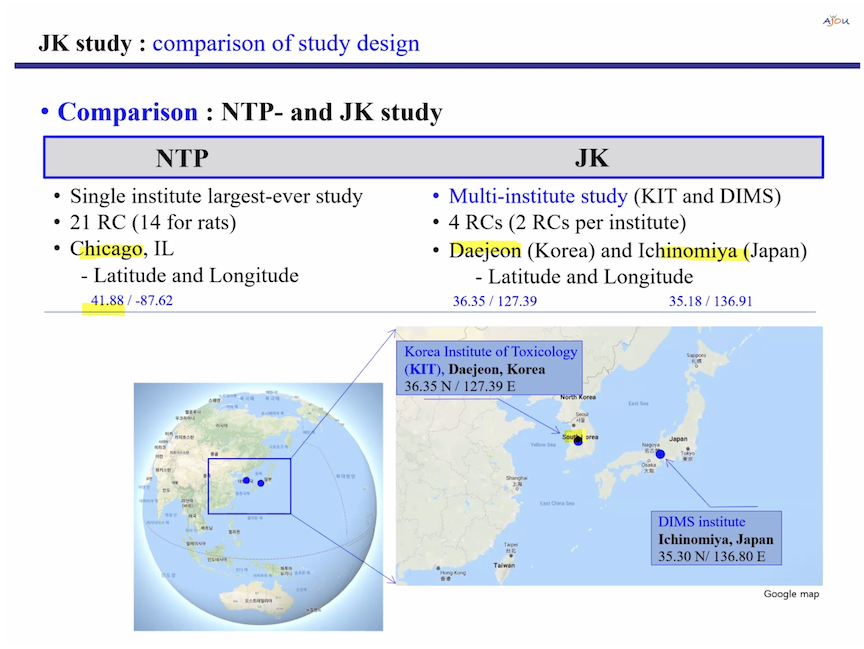
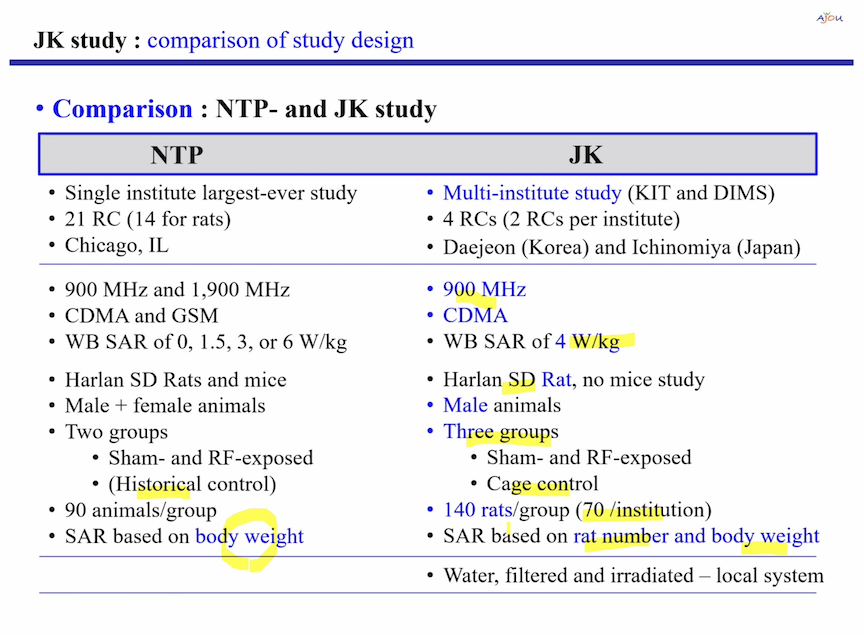 The next few slides give details on the study protocol, with some preliminary results on animal weights and food consumption.
The next few slides give details on the study protocol, with some preliminary results on animal weights and food consumption.
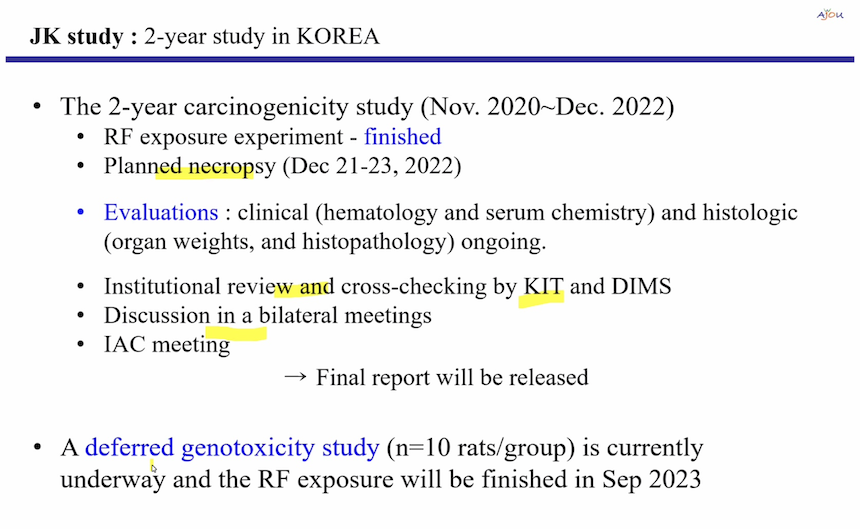 Ahn closed his talk with this summary:
Ahn closed his talk with this summary:
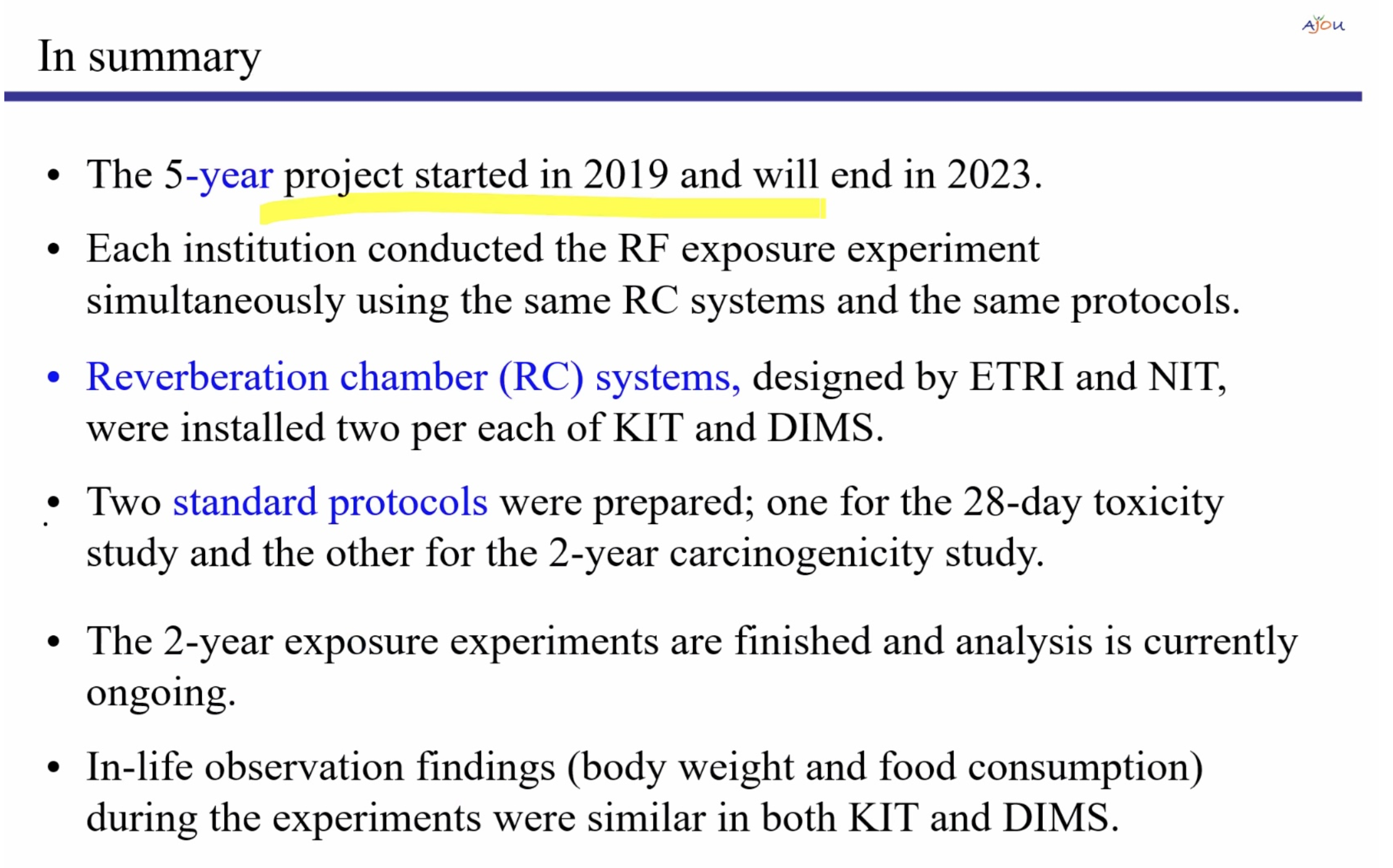
A pdf of Ahn’s complete ppt is available here.
Members of the project’s international advisory committee are: Alexander Lerchl, Michael Repacholi, Emilie van Deventer, Eric van Rongen, Vijayalaxmi, Joe Wiart and Michael Wyde.
Last year, Ahn’s and Imaida’s teams described the joint animal project in a paper published in Bioelectromagnetics. It’s open access.
Briefing in Geneva This Week
Japanese-Korean ‘NTP Lite’ on the Agenda
ICNIRP continues to dominate EMF policies at the WHO, according to documents made available to Microwave News. The International Commission on Non-Ionizing Radiation Protection is a private, self-perpetuating, secretive group whose exposure limits are used around the world.
The documents were recently distributed by Emilie van Deventer, who leads the WHO’s radiation program, as she prepared to host a briefing this week in Geneva for the EMF International Advisory Committee (IAC).
The meeting, which has not been publicized, will offer fresh details on a Japanese-Korean animal study, the slimmed down version of the NTP’s $30 million rat study with “clear evidence” of cancer (the repeat has been called “NTP Lite”). The results of the joint study have been highly anticipated since last November, when the director of IARC said that she is waiting for them before scheduling a new assessment of RF cancer risks.
Young Hwan Ahn of Korea’s Ajou University medical school will provide the update tomorrow, June 6, on the first day of the IAC meeting. Unlike many of the speakers attending remotely, Ahn will be in Geneva, according to a leaked copy of the draft agenda.
The complete draft agenda is here.
Surprisingly, the agenda does not mention the decade-long effort to update the WHO’s RF Environmental Health Criteria (EHC) document. There was an extended discussion of the EHC at last year’s IAC meeting, according to the draft minutes, which were also leaked (the full text of the minutes are here).
Last December, WHO announced the formation of an RF Working Group to help guide the RF EHC to completion. The working group held its first meeting in March. This too was not publicized, and van Deventer has yet to disclose how the working group was assembled. (For a history of the RF EHC, see our detailed report.)
ICNIRP, ICNIRP, ICNIRP
The 2022 IAC meeting, held online, was run by Eric van Rongen, the former chair and current vice chair of ICNIRP. This year’s session also features strong ICNIRP participation, including that of three Australians: Rodney Croft, the current chair, Ken Karipidis, a commissioner, and Sarah Loughran, Croft’s right-hand aide, who serves as an ICNIRP scientific expert. Only Loughran plans to attend the meeting in person.
Among the other scheduled speakers this week are David Sliney, a former ICNIRP commissioner who is now an ICNIRP expert, and Maria Scarfi who served as an expert from 2006 to 2012. Gunde Ziegelberger, the Commission’s scientific secretary, will also speak.
Scarfi and Isabelle Deltour, Joachim Schüz’s protégée at IARC, will review recent health studies. Deltour has spent the last decade challenging IARC’s 2011 designation of RF as a possible human carcinogen.
Contributions from Five Countries
At last year’s IAC meeting, van Deventer disclosed that only five countries had provided financial support for the WHO EMF Project in the previous year: Australia, Ireland, Israel, New Zealand and Switzerland. She noted that others had contributed staff time, helped host meetings and provided translation services. The combined population of the five countries is about 50 million; half are Australians.
The WHO EMF project, like ICNIRP, rarely offers information about its sources of funding.
Providing Oversight
One of your objectives is to provide “oversight on the conduct of the [EMF] Project,” van Deventer has told Committee members (see slide below). And last year she committed to “increasing emphasis on transparency in all areas of its work, including funding, data and partnerships, and making WHO information available to everyone.”
This was reported in the minutes of the meeting by Martin Gledhill, New Zealand’s representative on the IAC —without a trace of irony.
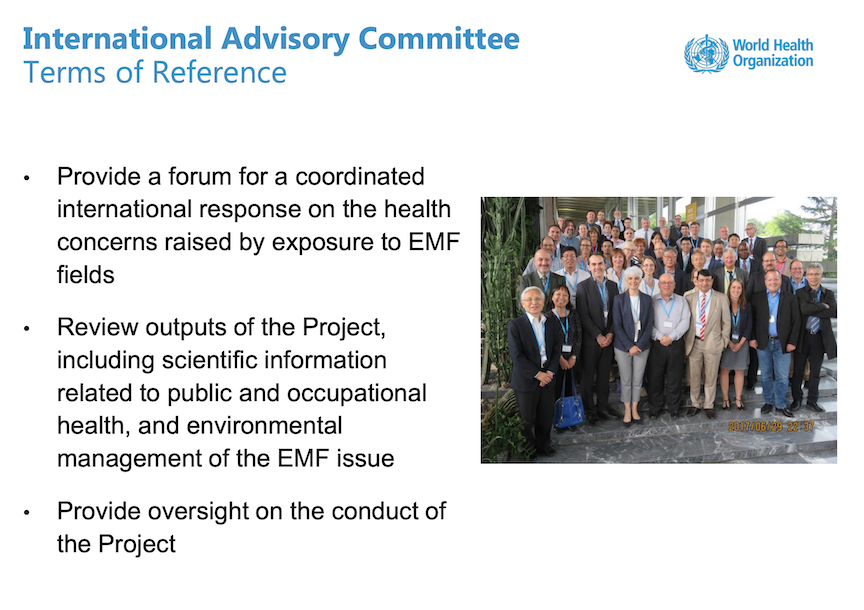 A slide from Emilie van Deventer’s presentation at 2019 IAC meeting.
A slide from Emilie van Deventer’s presentation at 2019 IAC meeting.
She is fourth from the left in the front row.
Van Deventer runs a closed shop with essentially no public outreach. She and her staff have declined to share the most basic information or documents on WHO’s EMF work and, on most occasions, they do not respond to email inquiries.
The IAC meeting will also address other types of non-ionizing radiation, including UV and optical frequencies.
Declassified Intelligence Report Renews Concern over RF Weapons
A newly declassified, though heavily redacted, report from the intelligence community has put renewed emphasis on the possibility that the condition known as “Havana Syndrome” could be caused by pulsed RF energy.
“Electromagnetic energy, particularly pulsed signals in the radiofrequency range, plausibly explains the core characteristics [of Havana Syndrome, also called ‘anomalous health incidents’] although information gaps exist,” the intelligence panel concluded.
The report, Anomalous Health Incidents: Analysis of Potential Causal Mechanisms, was prepared for the Director of National Intelligence, Avril Haines, and the Deputy Director of the CIA, David Cohen. It was released to attorney Mark Zaid at the James Madison Project in Washington, DC. Salon broke the news yesterday evening.
The names of the authors of the report were censored. “The panel comprised experts from inside and outside the U.S. Government with expertise in relevant areas of science, medicine and engineering,” according to the report. All had top secret clearances.
Symptoms of Havana Syndrome include hearing loss, vertigo, headaches, nausea and various other unexplained neurological complaints.
Support for 2020 Findings of the National Academy of Sciences
The new report, dated September 2022, supports the conclusions of a 2020 assessment by a committee of the National Academy of Sciences, chaired by Stanford University professor David Relman. That panel found:
Considering the available information and the possible mechanisms, the committee felt that many of the distinctive and acute signs, symptoms, and observations reported by Department of State employees “are consistent with the effects of directed, pulsed radio frequency (RF) energy.”
Only about a third of the members of Relman’s group had security clearances. Linda Birnbaum, the former director of NIEHS and the NTP, was a member of the NAS panel.
Two years later, Relman was still concerned about RF radiation. “We have identified an area of science and medicine that I think is very important that we really don’t know a whole lot about,” he told CNN. “How does the human body interact with electromagnetic energy? We really need to understand that better.”
Others believe that Havana Syndrome is a form of mass hysteria. For instance, just last week, Robert Bartholomew, a sociologist, writing in Psychology Today called the whole controversy a “fiasco.” All those symptoms were “not caused by a secret weapon, but an array of health conditions and anxiety,” he argued.
Key Findings
The key conclusions of the new intelligence committee report are:
• “The signs and symptoms of AHIs are genuine and compelling.”
• “A subset of AHIs [has] a unique combination of core characteristics that cannot be explained by known environmental or medical conditions and could be due to external stimuli.”
• “Electromagnetic energy, particularly pulsed signals in the radiofrequency range, plausibly explains the core characteristics, although information gaps exist.”
• “Ultrasound also plausibly explains the core characteristics, but only in close-access scenarios and with information gaps.”
• “Psychosocial factors alone cannot account for the core characteristics, although they may explain some other reported incidents or contribute to long-term signs and symptoms.”
• “Ionizing radiation, chemical and biological agents, infrasound, audible sound, ultrasound propagated over large distances, and bulk heating from electromagnetic energy are all implausible explanations for the core characteristics in the absence of other synergistic stimuli.”
Here are three noteworthy snippets from the new report (unfortunately, the references are not included in what was released):
On the blood-brain barrier (p.7):
On the auditory effect first described by Allan Frey (p.25):
On low-frequency modulation/high-frequency carrier (p.28):
Professor Allowed Back on Campus; No Action Taken
The University at Albany in New York State has closed its investigation of Professor David Carpenter, the director of its Institute for Health and the Environment, without taking any disciplinary action.
After being barred from going to his office most of last year, Carpenter may now once again “teach and conduct research on campus,” according to a statement released by the University on Tuesday evening.
The full text of the statement is below:
 On Wednesday, Carpenter issued his own statement, in which he says that he’s “very proud of [his] work with plaintiffs around the country who seek to hold Monsanto responsible for the damage done by its products.” And that he is “humbled and deeply appreciative of the thousands of people who heard about my situation and supported me.” (Full text, below.)
On Wednesday, Carpenter issued his own statement, in which he says that he’s “very proud of [his] work with plaintiffs around the country who seek to hold Monsanto responsible for the damage done by its products.” And that he is “humbled and deeply appreciative of the thousands of people who heard about my situation and supported me.” (Full text, below.)

Carpenter Placed on “Alternate Assignment”
Just over two weeks ago, on February 5, the Albany Times Union reported that Carpenter had been “quietly placed on alternate assignment” as the University conducted a “disciplinary investigation” of his work as an expert witness on the health effects of PCBs, a family of highly toxic chemicals, formally known as polychlorinated biphenyls. They were manufactured by Monsanto until they were banned by the EPA in the late 1970s. (More about PCBs here.)
While this investigation was going on, Carpenter was “instructed to not visit any campuses and perform his duties from home,” according to the Times Union.
It is not clear what Carpenter is accused of doing wrong. He donated all his consulting fees, except those for travel expenses, to fund scholarships for his students, with, as the Times Union spells out, “the consent of top university officials.”
His suspension prompted widespread protests. A petition decrying Monsanto’s attacks on Carpenter —posted on Change.org— has been signed by more than a thousand supporters. A rally to draw public attention to his predicament was scheduled to be held at the state capitol in Albany on Thursday, February 23.
Among the professional groups speaking out for Carpenter are the Ramazzini Institute, based in Bologna, Italy, and the International Commission on the Biological Effects of EMFs (ICBE-EMF). The Commission’s release states that Albany’s attempt to silence Carpenter “brings shame to this University.”

In an editorial, Environmental Health News accused the university of helping Monsanto silence Carpenter.
“UAlbany reiterates in the strongest possible terms our full commitment to unfettered academic freedom,” the University stated in its public announcement.
The university’s investigation was prompted by a records request by the Shook Hardy & Bacon law firm, working on behalf of Monsanto, in its litigtion on PCBs. (What remains of Monsanto is now owned by Bayer.) Monsanto is also the maker of Round-Up, a glyphosate herbicide, which has been and continues to be at the center for another major health controversy.
In 2015, IARC classified PCBs and dioxin-like PCBs as a known (Class 1) human carcinogen.
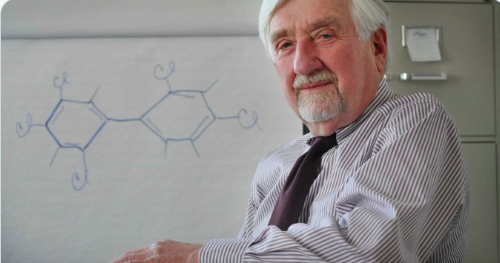 David Carpenter, photo by Paul Buckowski, Times Union
David Carpenter, photo by Paul Buckowski, Times Union
On February 13, the Times Union published a follow-up story detailing how Shook Hardy was using the university’s investigation to try and silence Carpenter in an ongoing case in which he is serving as an expert witness for the Saint Regis Mohawk Tribe. The tribe is suing Monsanto for PCB contamination of its lands, that are adjacent to a chemical dump.
A Major Force in EMF/RF Research
In addition to his work on toxic chemicals, for over 40 years Carpenter has been a leading force in efforts to study and regulate the health effects of electromagnetic fields (EMFs) and radiation.
He led the New York Power Line Project in the early 1980s, which resulted in the confirmation of the landmark epidemiological study by Nancy Wertheimer and Ed Leeper, which first linked power line EMFs to childhood leukemia. The NY project report, issued in 1987, brought international attention to the power line cancer risk. Fifteen years later, in 2001, IARC classified power-frequency fields as a possible (class 2B) carcinogen.
In 1994, Carpenter and Sinerik Ayrapetyan coedited a two-volume collection of review papers, under the title, The Biological Effects of Electric and Magnetic Fields, published by Academic Press.
Carpenter is the coeditor, with Cindy Sage, of the BioIniative Report, which promotes stricter exposure standards for EMFs and RF radiation. First issued in 2007, the Report has been regularly updated.
More recently, Carpenter has raised questions about the safety of 5G radiation, the latest generation of cell phone technology. For this, he was harshly criticized in two separate articles by William Broad, a science reporter at the New York Times. They were published just a few months apart in 2019 (see our “A Fact-Free Hit on a 5G Critic” and “Open Season on 5G Critics”). At about the same time, the Times announced that it had “joined forces with Verizon to create the 5G Journalism Lab.” (See this paid post on the New York Times website.) Verizon is one of the largest telecom companies in the world with revenues on the order of $150 billion a year.
Carpenter, who is 86-year-old, is one of two editors-in-chief of Reviews on Environmental Health, a journal published by De Gruyter.
The Times Union story on Carpenter’s reinstatement is here.
See also: “Professor Says He Was Barred from Campus After FOIA Inquiry,” Inside Higher Ed, February 20.
Abraham Liboff, a biophysicst and journal editor, died on January 9 at the age of 95.
Abe was a wonderful and generous man. On the occasion of his 90th birthday, I wrote an appreciation of his work. You can read it here.
Tribute in Electromagnetic Biology and Medicine
March 21, 2023
Joseph Salvatore and Henry Lai, the current and former editors-in-chief of the journal Electromagnetic Biology and Medicine, have published a tribute to Abe Liboff.
Liboff was the editor of the journal from 1998 to 2010.
“His work has inspired generations of nonionizing-electromagnetic field (EMF) researchers,” they write. “His influence will be felt for many years to come.”
Their tribute is open access.


